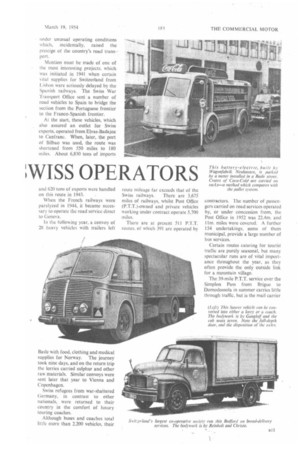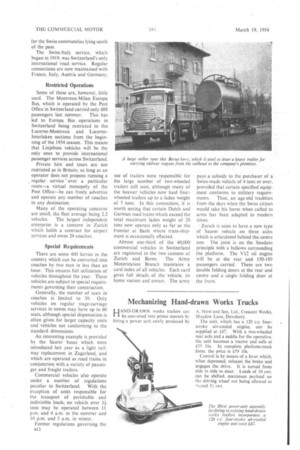A LIGHT REIN OT NISS OPERATORS
Page 44

Page 45

Page 46

If you've noticed an error in this article please click here to report it so we can fix it.
by W. H. Godwin
GOODS and public service vehicle operators in Britain may envy the apparent freedom enjoyed by their counterparts in Switzerland, but even there the problem of competition between road and rail is a real one.
In the past, this problem has given rise to acute differences of opinion, and unsuccessful atiempts have been made to implement legislation empowering the Federal authorities to co-ordinate transport services. A referendum for this purpose was rejected by a large majority in 1946, and a further attempt in 1951 fared no better.
Swiss experts are averse to further nationalization—the policy of state ownership of the railways adopted more than 50 years ago was completed by 1909—but in 1949 an interim measure, the "Statute des transports automobiles," called a halt to the uncontrolled multiplication of road vehicles operated for hire or reward, but this expired in 1951.
Since then, there have been no restrictions on road haulage, although development over the past two years has again shown that unchecked competition between road and rail can only be detrimental to the economic structure of the country.
As there was no hope of co-ordination being implemented on 'a legal basis for some years, the wellequipped Swiss Federal Railways (S.B.B.) and Treuhandverband des Autotransportgewerbes (T.A.G.), the BIO Swiss counterpart of our Road Haulage Association, made a voluntary agreernent which came into force in May, 1952.
Under the agreement, the railways have relinquished their right to operate road vehicles over and above the scale previously worked, and the hauliers have limited both the number and carrying capacities of their vehicles. T.A.G. members also agreed to adhere to established rates and charges, and to observe all legal requirements in connection with vehicle fitness and working hours.
Initially, there was no obvious advantage in joining T.A.G., but privileges now offered to members include the exclusive right to handle loads to and from the Rhine port at Basle_ Road transport's share of this traffic rises steadily, and is shared only with C-licensed vehicles, a category becoming of great importance in Switzerland.
In June, 1951, United Nations experts carried out a sample survey of road transport in Switzerland, and this showed the tonnage carried by C-licensed vehicles to be 57.6 per cent. of the total of 2.5 m. This, incidentally, compared with 2.3m. tons carried by the railways. Vehicles operated for hire or reward were responsible for 31.2 per cent. and mixed traffic for 11.2 per cent.
Swiss cross-frontier long-distance traffic, which was of little importance before the war, was brought into the limelight towards the end of, and immediately after, the late war. Valuable experience was gained then and 620 tons of exports were handled on this route in 1943.
When the French railways were paralyzed in 1944, it became necessary to operate the road service direct to Geneva.
In the following year. a convoy of 28 heavy vehicles with trailers left Basle with food, clothing and medical supplies for Norway. The journey took nine days, and on the return trip the lorries carried sulphur and other raw materials, Similar convoys were sent later that year to Vienna and Copenhagen.
Swiss refugees from war-shattered Germany, in contrast to other nationals, were returned to their country in the comfort of luxury touring coaches.
Although buses and coaches total little more than 2.200 vehicles, their route mileage far exceeds that of the Swiss railways. There are 3,675 miles of railways, whilst Post Office (P.T.T.)-owned and private vehicles working under contract operate 5,700 in There are at present 511 P.T.T. routes, of which 391 are operated by contractors. The number of passengers carried on road services operated by, or under concession from, the Post Office in 1952 was 22.4m: and 11m. miles were covered. A further 154 undertakings, some of them municipal, provide a large number of bus services.
Certain routes catering for tourist traffic are purely seasonal, but many spectacular runs are of vital importance throughout the year, as they often provide the only outside link for a mountain village.
The 39-mile P.T.T. service over the Simplon Pass from lirigue to Domodossola in summer carries little through traffic, but is the mail carrier for the Swiss communities lying south of the pass.
The Swiss-Italy service, which began in 1919, was Switzerland's only international road service. Regular connections are now maintained with France, Italy, Austria and Germany.
Restricted Operations
Some of these are, however, little used. The Montreux-Milan Europa Bus, which is operated by the Post Office in Switzerland carried only 688 passengers last summer. This has led to Europa Bus operations in Switzerland being restricted to the Lucerne-Montreux and LucerneInterlaken sections from the beginning of the 1954 season. This means that Linjebuss vehicles will be the only ones to provide international passenger services across Switzerland.
Private hire and tours are not restricted as in Britain; so long as an operator does not propose running a regular service ' over a particular route—a virtual monopoly of the Post Office—he can freely advertise and operate any number of coaches to any destination.
Many of the operating concerns are small, the fleet average being 2.2 vehicles. The largest independent enterprise is a concern in Zurich which holds a contract for airport services and owns 29 coaches.
Special Requirements
There are some 400 lorries in the country which can be converted into coaches by two men in less than an hour. This ensures full utilization of vehicles throughout the year. These vehicles are subject to special requirements governing their construction.
Generally, the number of seats in coaches is limited to 30. Only vehicles on regular stage-carriage services in towns may have up to 60 seats, although special dispensation is often given for larger capacity units and vehicles not conforming to the standard dimensions.
An interesting example is provided by the Saurer buses which were introduced last year as a light railway replacement in Zugerland, and which are operated as road trains in conjunction with a variety of passenger and freight trailers.
Commercial vehicles also operate under a number of regulations
peculiar to Switzerland. With the exception of units responsible for the transport of perishable and indivisible loads, no vehicle over 31 tons may be operated between 11 p.m. and 4 a.m, in the summer and 10 p.m. and 5 a.m. in winter.
Former regulations governing the
612
use of trailers were responsible for the large number of two-wheeled trailers still seen, although many of the heavier vehicles now haul fourwheeled trailers up to a laden weight of 7 tons. In this connection, it is . worth noting that certain Dutch and German road trains which exceed the total maximum laden weight of 20 tons now operate only as far as the frontier at Basle where trans-shipment is occasionally effected.
Almost one-third of the 40,000 commercial vehicles in Switzerland are registered in the two cantons of Zurich and Berne. The Army Motorization Branch maintains a card index of all vehicles. Each card gives full details of the vehicle, its home station and owner. The army pays a subsidy to the purchaser of a Swiss-made vehicle of 4 tons or over, provided that certain specified equipment conforms to military require ments. Thus, an age-old tradition from the days when the Swiss citizen would take his horse when called to arms has been adapted to modern times.
Zurich is soon to have a new type of Saurer vehicle on three axles which is articulated behind the centre one. The joint is on the Snodato principle with a bellows surrounding the platform. The V12 oil engine will be at the rear and 150-180 passengers carried. There are two double folding doors at the rear and centre and a single folding door at the front.




































































































